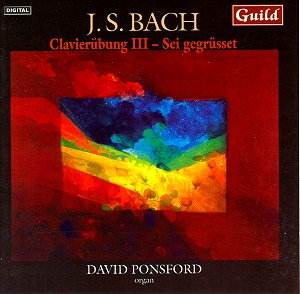The third part of the
‘Clavier-Übung’ was the first collection
of music for organ that Bach published,
in 1739. The title explains what it
is all about: "Third part of the
Clavier Übung consisting of various
preludes on the catechism and other
hymns, for the organ". It was the
first time Bach devoted organ works
to the Lutheran catechism. It is not
known for what reason Bach composed
these works. It is suggested it was
connected to the celebrations marking
the bicentenary of the Augsburg Confession
on 12 August 1739.
The collection contains
several settings of the German Kyrie
and Gloria, two settings – one pedaliter
(for manuals and pedal) and one manualiter
(for manuals only) – of each of the
six catechism chorales and four duets.
The collection opens with the Prelude
and closes with the Fugue in E flat
(BWV 552). The Clavier-Übung is
without any doubt devoted to the Holy
Trinity, symbolised by the number 3,
which appears in many different ways
in the collection.
The liner notes are
written by David Ponsford himself. He
concentrates mainly on the musical structure,
whereas his references to the symbolism
in this collection are rather fragmentary.
Sometimes his remarks are unclear or
present assumptions or possible interpretations
as facts. In ‘Dies sind die heilgen
zehn Gebot’ (BWV 678) "the melody
is treated in a canon for two voices
symbolising the law". The reader
is left with the question what is symbolising
the law: the two voices or the canon
form? And in what way do they symbolise
the law?
His view that the juxtaposition
of the Italian style of the pedaliter
setting of ‘Wir gläuben all an
einen Gott’ (BWV 680) and the French
overture style of the manualiter setting
(BWV 681) is a symbol of the "inclusive
and ecumenical nature of the Creed"
seems rather far-fetched. And he believes
the final 5-part Fugue "represents
Luther’s Evening Blessing", a view
which is certainly not universally shared
and which he fails to argue.
An example of incomplete
information is the description of the
Partite diverse sopra ‘Sei gegrüßet,
Jesu gütig’ (BWV 768), a chorale
setting with 6 variations for manuals
only and 5 for manuals and pedal. Ponsford
presents this work as variations on
a Passiontide chorale. He should have
added that this piece appears in some
manuscripts under the title ‘O Jesu,
du edle Gabe’, which is a Communion
chorale. He also should have informed
the reader that the variations appear
in different orders in different manuscripts
and that the order he uses is only one
possibility.
Although the liner
notes suggest Ponsford has paid attention
to the symbolism in Bach’s music, he
sometimes misses the point. The pedaliter
setting of ‘Dies sind die heilgen zehn
Gebot’ (BWV 678) contains sighing motifs
(‘Seufzer’) and falling chromaticism,
which could be interpreted as an expression
of the inability of mankind to obey
God’s law. In Ponsford’s performance
these sighing motifs go by unnoticed,
like in ‘Vater unser im Himmelreich’
(BWV 682).
In other cases Ponsford
shows awareness of Bach’s symbolism
but fails to do justice in his performance.
In regard to ‘Christ unser Herr zum
Jordan kam’ (BWV 684) he rightly states:
"Pictorial symbolism may well lay
behind the left-hand semiquaver sequences
(...). The melody (in the pedal) appears
immersed in the waves of the River Jordan,
whilst the leaping right-hand motifs
are thought to represent signs of the
Cross." But in his interpretation
the cantus firmus is registered in such
a way that it overpowers the other voices
which seriously undermines the symbolism
of the piece. The same problem appears
in BWV 678 and in the Partita X from
BWV 768. It is right that the cantus
firmus should be clearly audible but
it should never be registered in such
a way that the balance between the voices
is upset.
This brings me to the
registration, which I often find unsatisfying.
Some pieces are composed in French style,
like ‘Wir gläuben all an einen
Gott’ (BWV 681) and ‘Vater unser im
Himmelreich’ (BWV 682). Ponsford has
registered them with stops that are
characteristic for French baroque organs.
But the organs Bach has played didn’t
have that kind of stops, so these registrations
are unhistorical. In general Ponsford
seems to prefer rather loud, sometimes
even obtrusive registrations.
This is not the only
thing that causes me problems in his
interpretation. The articulation is
fairly inconsistent: legato, non-legato,
even staccato. And all notes are treated
equally, without a clear distinction
between ‘good’ and ‘bad’ notes. I find
his playing rather mechanical and lifeless.
It just doesn’t breathe.
I have to say something
about the organ. It is a modern organ,
built in 1990 by Peter Collins, with
mechanical action. "The tuning
temperament is by Neidhardt (1724),
an unequal temperament that gives individual
character to every tonality". This
suggests the organ has been built according
to historical principles. But that is
not the case. I can’t see what the historical
justification is of putting ‘German’
and ‘French’ registers together in one
organ. The overall sound of the organ
is unpleasant, almost aggressive. The
very direct recording only makes it
worse.
I am not very happy
with this recording. In these works
Bach shows a deep understanding of the
Biblical teaching and orthodox Lutheran
doctrine. But organist and organ don’t
have the eloquence to reveal the way
Bach has expressed them in his music.
Johan van Veen
Peter
Wells was rather happier with this recording



